Epidotes (silicates): Beryl
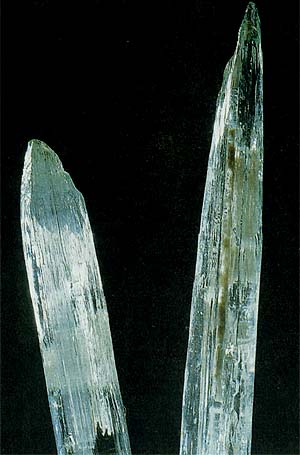 Diagnostic card.
Diagnostic card.
On the picture. Beryl crystals from the State of Minas-Zhrvays (Brazil). Below: a short-prismatic beryl crystal with a distinctly identified hexagonal habit.
Be 3 Al 2 Si 6 O 18
Shingoniya hexagonal
Hardness 7,5-8
Specific weight 2.68-2.9
Cleavage imperfect along the base
Cracked shell
Color is colorless, differently colored
Color in powder white
Glitter glass
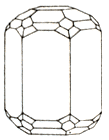
Beryl in addition to the emerald and aquamarine has a number of varieties. His name he received from the Greek beryllos, probably of Indian origin; The original value is not set. In ancient times, optical glasses were made of colorless beryl.
Varieties of beryl, differing in color, have different trade names. The general properties of all beryl are stability with respect to various reagents, except hydrofluoric acid, as well as transverse separation and brittleness (when the beryllium is compressed easily, they crack easily) and bright glass shine. Crystallize beryls in the voids of granite pegmatites, greisens and quartz veins. They are also extracted from weathering crusts on pegmatites and alluvial placers.
Goshenit - colorless transparent beryl. Its name was received at the site of the find - Goshen in Connecticut (USA). It is sometimes used to simulate diamonds and emeralds (with a silver or green foil under the stone). A tabular variety of colorless beryl goshenit is called rosterite.
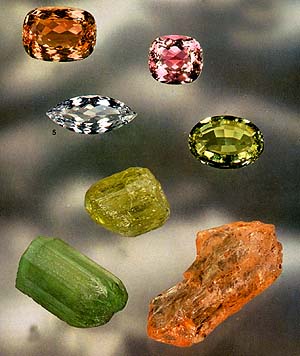 The chemical composition of beryl, one of the most important precious stones, can also include sodium, potassium, lithium, calcium, cesium, rubidium, scandium, fluorine and hydroxyl. The shape of the crystals is prismatic, often the apices are broken incorrectly or end with bipyramids.
The chemical composition of beryl, one of the most important precious stones, can also include sodium, potassium, lithium, calcium, cesium, rubidium, scandium, fluorine and hydroxyl. The shape of the crystals is prismatic, often the apices are broken incorrectly or end with bipyramids.
Greenish beryls become aquamarine when heated. Grinded beryls, as a rule, step cut. Opaque differences in processing tend to reveal the effect of a "cat's eye" or asterism, polishing them with a cabochon. A variety of colors gives an occasion to confuse beryls with so many precious stones.
Dimensions are noteworthy: specimens of a height of more than 1 m and a diameter of 20-30 cm are not uncommon. Beryl without impurities is usually colorless, but most often has azure-green or, more rarely, yellow and pink. The most valuable varieties of beryl, known as emerald and aquamarine, are painted in green and blue in different shades.
Crystals are hexahedral prisms. Varieties: emerald, aquamarine, heliodorus, sparrow (precious stones), rosterite. It occurs in pneumatolitic-hydrothermal deposits, in pegmatites, greisens, quartz veins, etc. Beryllium ore. The chemical composition-content (in%): BeO-14.1, Al2O3-19; Si02 = 66.9; Impurities of sodium, potassium, lithium, cesium, rubidium, iron, vanadium, and sometimes chromium are noted.
Color transparent dense green chrome-containing - emerald, blue (greenish blue) - aquamarine, golden yellow - heliodorus, pink cesium-containing - sparrow (morganite), very rare red - bixbit, colorless - rosterite (goshenit), dark blue maxis -beryl. Singonia is a hexagonal, dihexagonal-dipyramidal symmetry. Cleavage is absent; Sometimes separate from the pinacoid (0001). Aggregates. Dense, interspersed.
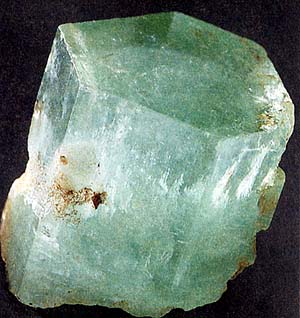 Diagnostic signs.
Diagnostic signs.
It does not lend itself to the action of acids, it melts in the flame of a candle. Due to the characteristic shape and color it can not be confused with anything.
Origin.
Beryl is a characteristic mineral of various types of pegmatites. Sometimes occurs in granites and crystalline schists. Due to its high resistance to weathering, it also accumulates in alluvial deposits formed during the mechanical destruction of primary rocks containing beryl.
Place of Birth.
The most valuable variety of beryl (emerald) has always been considered a jewel of the highest class. In ancient times, emeralds were mined at the deposits of Scythia and, to a large extent, Egypt. In our time, the richest deposits are discovered in Colombia (Chivor, Somon-doko, Muzo, Cascais, etc.). There are also well-known deposits in Brazil in the states of Minas Gerais and Bahia, Russian - in the Urals and Siberia, and African - in Zimbabwe. The deposits of India and the Salzburg Alps are of lesser importance.
Transparent and colored aquamarine differences are found in alluvial deposits of the Brazilian state of Minas Gerais and in the pegmatites of the Urals, Madagascar, Ireland and the USA. In Madagascar, Brazil and California, they extract a pink morganite; The finest crystals of this variety are also found on the island of Elba. The golden heliodor comes from South Africa and Brazil.
Application.
If beryl is not suitable for jewelry purposes (like emerald, aquamarine, heliodor and morganite), it is used as ore for beryllium. This element is very widely used, including in the production of light alloys used in aircraft construction.
Application in jewelry.
Almost all emeralds are cut with a ladder (step cut), which is called "emerald". For this, the stone, which has faces parallel to the primary hexagonal-prismatic form, is given an octagonal form, processing with a series of three upper rectangular facets and the same lower ones. Emeralds of medium quality are cut by a cabochon or shaped into a sphere. For aquamarine the most popular rectangular ladder. Oval cut is used, and for stones with inclusions, an external curve. This gem is also processed in the form of a sphere used for coulombs, and in the form of various ultramodern forms, especially common in Germany. Heliodorus is often used oval, less popular rotunda. The teardrop shape is ideal for earrings, as it reveals the game of golden rays characteristic of this stone. For morganite, the most widely used "emerald" cut.
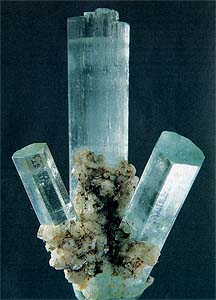
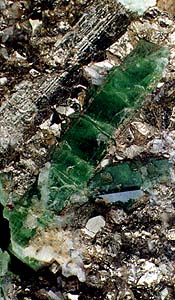
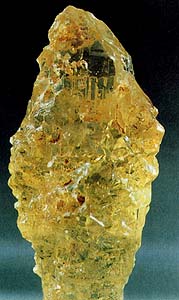
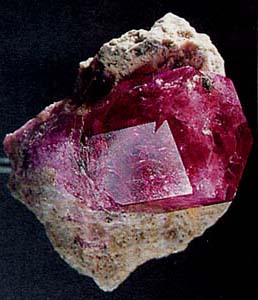
Beryl: Aquamarine
In nature it is represented by all shades from bluish-green to the most intense sky-blue. Glitter is glass. The crystals have the form of hexagonal prisms of elongated shape. Natural aquamarine sometimes contains gas-liquid inclusions. This is a typical pegmatite mineral found in Brazil, in Madagascar, and in the form of small crystals - on the island of Elba. For this semi-precious stone, a step-cut facet with rectangular facets is most often used.
Aquamarine - blue or greenish-blue transparent beryl, the color of which can be compared with the color of the water of the tropical sea. I received my name for coloring. Once the aquamarines were decorated with royal crowns, in addition they were used as lenses for glasses (the first lenses date back to 1300). The finest deposits of aquamarines are in Brazil, an aquamarine crystal weighing 110.5 kg was produced in one of the South American deposits. The largest of the known faceted stones weighs 2,594 carats.
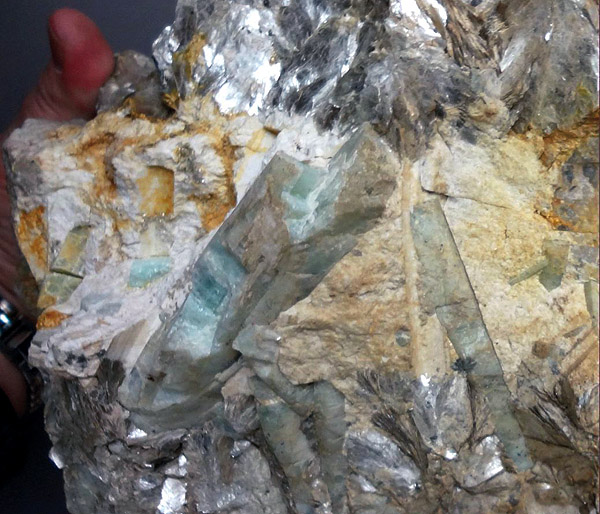
Beryl (blue crystals up to 9 cm), muscovite, wolframite (crystals up to 5 cm), quartz, etc.
Light deposit, Iultinsky ore. Rn, Chukotka, Russia, the CIS. Photo: © А.А. Evseev.

Beryl. In quartz with muscovite. Kirk-Bulak, Turkestan Range, Kirgizia, the CIS. Length 20 cm. Photo: © А.А. Evseev.
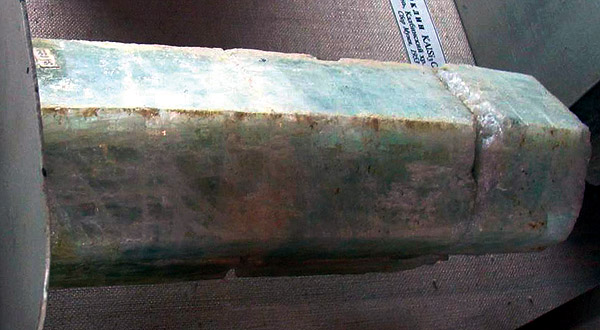
Beryl is deformed. Kirk-Bulak, Turkestan Range, Kirgizia, the CIS. Length 20 cm. Photo: © А.А. Evseev.
The most valuable stones are deep sky-blue. The color intensity increases after the crystal is heated above the temperature of 400 o C. Aquamarine is fragile, it can be easily crushed! The color is usually evenly distributed: aquamarines are much more often than emeralds, they are transparent. Chromophore is iron. The thinnest hollow tubules, which cause silvery-white light effects, are characteristic. If there are many such canals in a stone polished with cabochons, one can observe the effect of a "cat's eye" or asterism in the form of a six-beam star. The presence of various impurity elements causes fluctuations in physical properties. Significantly different in its constants once popular aqua-rin-maxiks from Brazil. But at the present time this variety of aquamarine almost does not go on sale, as its coloring under the influence of sunlight deteriorates with time. Deposits of aquamarine are known on all continents: the most significant of them are in Brazil (Minas Gerais, Bahia Espiritu Santo).
Aquamarines are extracted from pegmatites, often found in coarse-grained granites. In Madagascar, numerous aquamarine deposits are confined to the inner plateau. In the CIS there are known aquamarine deposits in the Urals and Transbaikalia. All other aquamarine deposits have only local significance; These are deposits of Australia (New South Wales). Burma. Sri Lanka. India, Kenya. Mozambique. SOUTH AFRICA. Namibia, Tanzania. USA (Colorado, Connecticut, California, Maine, North Carolina). Large crystals of aquamarine are found relatively often. The largest jewelry quality crystal was found in 1910 at the mine "Marambaya" in the state of Minas Gerais (Brazil). Its weight was 110.5 kg. Length 48.5 and a diameter of 41-42 cm. From this gigantic aquamarine was cut a lot of stones. Repeatedly found and aquamarine crystals weighing several tons, but they were always cloudy, opaque, and therefore unfit for cutting.
For aquamarines, it is preferable to use a step-cut or cut with wedges when rectangular or elongated-oval. Synthetic aquamarines are not manufactured. It is possible, but economically inexpedient and unreasonably expensive.
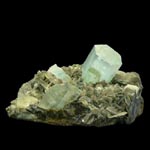
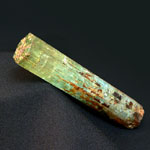
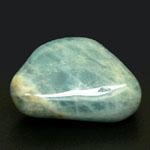
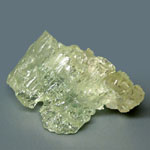
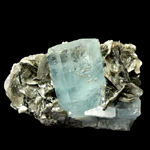
Beryl: The Emerald
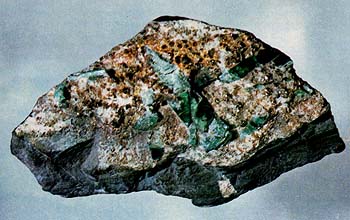 The crystals have a prismatic shape with short-columned or slightly elongated prisms. There is a glass shine and a slight pleochroism, which results in yellow and blue shades in different directions of the crystal, merging with the prevailing green. Obtained in Colombia, Brazil, Pakistan, Russia. The most commonly used step cut.
The crystals have a prismatic shape with short-columned or slightly elongated prisms. There is a glass shine and a slight pleochroism, which results in yellow and blue shades in different directions of the crystal, merging with the prevailing green. Obtained in Colombia, Brazil, Pakistan, Russia. The most commonly used step cut.
Emerald is the most valuable of the minerals of the beryl group. The deep and juicy shade of its green color can not be compared to anything, it is called "emerald green" (and not only in the application to minerals). The color of the emerald is due to the presence in its composition of chromium ions and sometimes vanadium; It is able to withstand sunlight and heat, changing only at a temperature of 700-800 o C.
Only emeralds of the highest quality are transparent. Most often they are clouded with inclusions of bubbles of liquid or gas, other minerals, and also healed cracks. Small inclusions are not considered significant defects, indicating the natural origin of the stone (as opposed to synthetic stones and all imitations). Specialists call them the French word "jardin" ("garden").
The stones of deep green tone are most valued; Even in the presence of inclusions, they are preferred to be pale-colored, even if almost transparent. Shine of an emerald is usually glass. Physical properties, especially density, light and birefringence, as well as pleochroism in emeralds from different deposits differ somewhat. A characteristic feature of the stone is its increased fragility; In combination with the often found in emeralds thin cracks of transverse separation, it makes this stone very sensitive to squeezing and heating. But with respect to acids and other reagents it is stable.
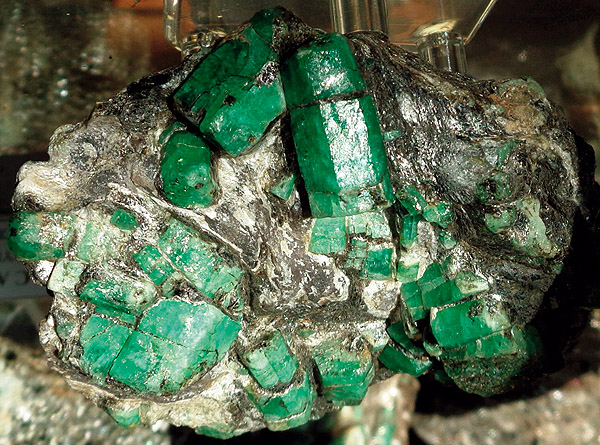
Emerald. Emerald mines, Av. Ural, Russia, the CIS. Photo: © А.А. Evseev.
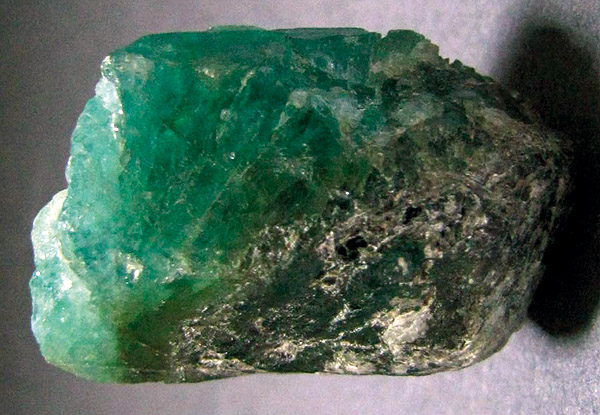
Beryl (different emerald). Capoeirana, Minas Gerais, Brazil. 3 cm. Photo: © А.А. Evseev.
Emeralds are formed by the interaction of acid magma with host ultrabasic rocks, so their deposits are represented by zones of greisenization of ultrabasic rocks (phlogopite mica), sometimes they are found in pegmatites or near them. But the best in quality emeralds are confined to hydrothermal veins occurring in carbonaceous shale. Alluvial deposits of an emerald are usually not formed, since in density it is close to quartz. Therefore, secondary deposits are represented only by weathering crusts.
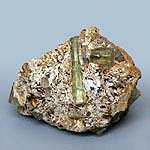 Beryl: Heliodorus
Beryl: Heliodorus
Golden beryl yellow. Its color varies from lemon-to golden-yellow and is caused by an admixture of ferrous iron. Occasionally, the stone contains inclusions. At 250 ° C it becomes discolored. The main deposits in Sri Lanka, Namibia.
Valued for its diamond shine and color, which varies from golden yellow to greenish-yellow. Being basically colorless and transparent, can have gas-liquid inclusions. Heliodor is mined mainly in Brazil, Sri Lanka and Ukraine. For him, mainly use a facet with an oval, less often a tondo shape. Yellow beryls are known as heliodores (from Greek to sunny). Sometimes, heliodoras are called lemon yellow and orange beryl, and davitsonites are golden. The yellow color of beryls is due to the presence of Fe3 + in tetrahedral and octahedral coordination.
Heliodorus sometimes differ exceptional purity and transparency, for example, the rare beauty of the bright golden beryls of Transbaikalia. Sometimes zoned crystals are found. In Siberia beryl there is a concentric zonation with a more yellow nucleus and a bluish fringe. In the golden beryl of Transbaikalia, alternating colors of different types along the length of the crystal are observed. Such beryl resemble polychrome tourmalines. The yellow color of heliodorus disappears when heated to 400 o C. The crystals become colorless or bluish. In heliodores there is a distinct dichroism: Ne - yellow, reddish-yellow, No - golden yellow. Density of 2.67-2.69 g / cm3. In the photo above - golden beryl from Ukraine.
Heliodor is a light greenish-yellow beryl. Was found in 1910 in the territory of present-day Namibia, where it got its name: in Greek heliodor - the gift of the sun. Heliodores of Namibia are weakly radioactive (impurities of uranium and rare earths). Previously, similar beryl already found in Brazil and Madagascar.
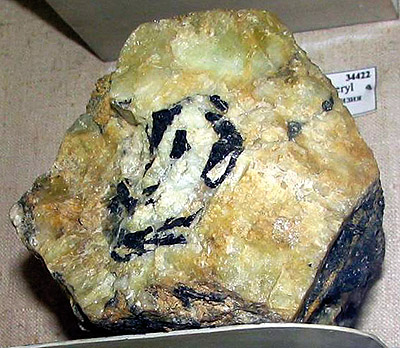
Beryl, "stuffed" tourmaline elbait (colored, sherle). Kirk-Bulak,
Turkestan Range, Kyrgyzstan (Central Asia), the CIS. ~ 15 cm. Photo: © А.А. Evseev.
For heliodorus, citrine, chrysoberyl, topaz, corundum, apatite, tourmaline, orthoclase, syngalite, synthetic spinel, and glass can be adopted. Among the properties and features of heliodor, having diagnostic value, it is necessary to single out rather low refractive indices, birefringence, density, characteristic absorption lines and the presence of liquid and gas-liquid inclusions located in cracks and tubular channels.
Beryl: Morganit (Vorobievit)
Pink beryls are known under two names: sparrow beetle (in Russia and a number of European countries) and morganite (in the USA). Its crystals, pink, orange-pink and - much less often - apricot-yellow, have a short-prismatic and tabular appearance. It is basically a transparent gem, sometimes with small inclusions. In rare cases, an iridescent color is observed. Large crystals of morganite, usually together with quartz and feldspars, occur in granite pegmatites of Brazil, Madagascar and California. The most suitable cut is emerald or ladder.
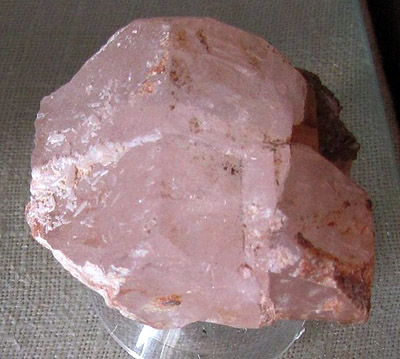
Beryl is pink. Lived Elizabeth, Pala, District of San Diego,
California, USA. Photo: © А.А. Evseev.
Morganite is beryl from gently pink to violet. The name was given by the name of the American collector J. Morgan (in the CIS pink beryl is commonly called sparrow). The density of morganite is 2.8-2.9. The color intensity increases after calcination at 400-450 o C. The most significant deposit is in Brazil (Minas Gerais), Madagascar, Mozambique, Zimbabwe, Namibia, USA (California).
Bixbit - pink-pink beryl. This name is rarely used, in the scientific literature, bixbit is not considered an independent species, but is considered a synonym for morganite (sparrowite).
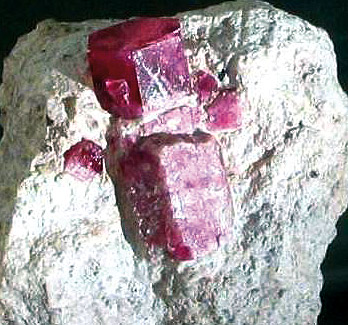
Beryl is red ("bixbit") in rhyolite. Ua-Ua Mountains, Utah, USA.
Crystal ~ 3 cm. Photo: © А.А. Evseev.
Beryllium (Be) is the destroyer of bones. The total amount of beryllium in the human body varies (according to different data) from 0.4 to 40 mcg. Beryllium is present in the blood, bone and muscle tissues (0.001-0.003 μg / g) and other organs. It is established that beryllium can be deposited in the lungs, liver, lymph nodes, bones, myocardium. Participates in the exchange of magnesium and phosphorus in the tissue. It has been established that the activity of beryllium compounds is clearly manifested in various biochemical transformations associated with the participation of inorganic phosphates.
To date, it has been shown to be toxic (including cytotoxic), sensitizing, embryotoxic and carcinogenic effects. Penetrating into the nuclei of cells, beryllium reduces the activity of DNA synthesis enzymes, in particular DNA polymerase, there are indications of the importance of DNA synthesis disorders for the appearance of abnormal proteins that play the role of autoantigens. In places of parenteral introduction of beryllium, destruction of surrounding tissues takes place, hence beryllium is very slowly excreted. In the end, beryllium is deposited in the skeleton and liver.
The main manifestations of excess beryllium: damage to the lung tissue (fibrosis, sarcoidosis) - inhale, skin lesions - eczema, erythema, dermatosis (with contacts of beryllium compounds with skin), berylliosis, casting fever (irritation of the mucous membranes of the eyes and respiratory tract); Erosion of the mucous membranes of the gastrointestinal tract (with food), impaired myocardial function, liver, development of autoimmune processes, tumors. The main pathway for the introduction of beryllium into the body is inhalation, i.e. Through the respiratory tract. People who work in conditions where there is inhalation of dust containing beryllium develops a professional disease - berylliosis (beryllium or chemical pneumonia).
The introduction of beryllium phosphate inhibits the inflammatory response. The beryllium antagonist is magnesium (in the body it is mainly located inside cells, where it forms compounds with proteins and nucleic acids containing Mg-N and Mg-O bonds). Increased beryllium content promotes the formation of beryllium phosphate. "Taking away" phosphates in the most important part of bones - calcium phosphate - beryllium weakens and destroys bone tissue (the solid component is calcium, similar to the action of acid on the bone). The introduction of the element causes "beryllium" rickets ("soft bones"). It is established that beryllium in the bones leads to their softening (there remains an organic connective tissue, soft and flexible bones).
Food sources of beryllium: the intake of beryllium with food and water is insignificant, significant amounts accumulate in tomatoes and leaf lettuce. According to modern ideas, beryllium is a toxic, carcinogenic and mutagenic element. The immunotoxic properties of beryllium have been studied. Elimination (withdrawal) of beryllium compounds from the body (especially from the organs of the lymphoid system where they accumulate) occurs extremely slowly, for 10 years. An increased level of beryllium occurs in workers in contact with an element in production.
Beryllium and its compounds have the ability to penetrate all organs, cells and their nuclei, into cellular organelles, in particular, into the mitochondria. It damages the cell membranes, including - and their lipid components, disrupting microviscosity. Beryllium inhibits the activity of the ATPase of the sarcoplasmic reticulum by inhibiting the transport of magnesium and calcium. When intratracheal administration of beryllium compounds occurs an increased yield of macrophages and polynuclei in the lumen of the alveoli. However, the mobility of macrophages is reduced, their organelles are damaged and DNA synthesis is reduced. On the basis of beryllium, the exit of vlisses from the cells of the body is ensured.
Rubidium (can be contained in beryl). The main manifestations of excess of rubidium: local irritation on the skin and mucous membranes; Chronic inflammation of the upper respiratory tract; Arrhythmias, sleep disturbances; headache; Proteinuria. Rubidium in the human body plays the role of stimulator of the nervous, cardiovascular systems, it raises blood pressure, has antihistamine action. The stimulating effect of rubidium on the functions of blood circulation (destruction of tissues for their regeneration) and the effectiveness of its salts in hypotension have been established. Burning action on the fabric. Antihistamine. Potassium is a rubidium antagonist.
Rubidium is necessary: in the treatment of many diseases of the nervous and muscular systems, in particular, with weakness, loss of strength, anemia. In connection with antihistamine action can be useful in various kinds of allergic diseases. Signs of rubidium deficiency: decreased appetite; Low mood; Asthenic manifestations; Stunted growth and development; Abortions; Premature birth. Most rubidium (about 40%) enters the body with tea and coffee. Thus, black tea contains 100 mg / kg of rubidium. Rubidium salts were used to strengthen the nervous system, and later - as an antiepileptic and hypnotic.
In the human body contains about 1 g of rubidium (causes cannibalism in its absence in the body, "Cook's syndrome" - Australia). Rubidium is in the state associated with erythrocytes, its concentration in erythrocytes is higher than in plasma. 80% of rubidium is absorbed in the gastrointestinal tract. Transport mechanisms of cells do not distinguish rubidium and potassium ions, they can compete among themselves. After absorption, it accumulates in the brain and skeletal muscles. Can accumulate in the placenta. The concentration in the bones is 26.7 μg / g, ovaries 20 μg / g, lungs 9.2 μg / g, soft tissues about 7.8 μg / g. It is excreted from the body with urine (up to 70%).
ADR 4.3


Substances that emit flammable gases in contact with water
Risk of fire and explosion if exposed to water.
The cargo, which crumbled, must be covered and kept dry
Blue and blue diamond, ADR number, black or white flame
ADR 8

Corrosive (corrosive) substances
Risk of burns from skin corrosion. They can react violently with each other (components), with water and other substances. The substance that spilled / crumbled can emit a corrosive vapor.
Dangerous to aquatic environment or sewer system
White upper half of diamond, black - lower, equal, ADR number, test tubes, hands
| The name of a cargo that is particularly dangerous for transportation | room
UN |
Class
ADR |
| RUBIDIUM | 1423 | 4.3 |
| RUBIDIA HYDROXIDE | 2678 | 8 |
| RUBIDIA OF HYDROXIDE SOLUTION | 2677 | 8 |
Physical features of natural minerals of the radioactive group
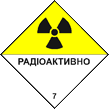 This mineral contains radioactive components . From the point of view of crystal physics, natural stones of small and small size, thin - they are colored by an insignificant number of natural compounds of radioactive elements and contain them in small amounts are correct and safe from the point of view of the level of radiation (up to 19-24 milli / g / h). It is a museum mineral, especially of large sizes .
This mineral contains radioactive components . From the point of view of crystal physics, natural stones of small and small size, thin - they are colored by an insignificant number of natural compounds of radioactive elements and contain them in small amounts are correct and safe from the point of view of the level of radiation (up to 19-24 milli / g / h). It is a museum mineral, especially of large sizes .
If the minerals are colored intensively and have large dimensions, the likelihood is high that this causes an increased natural level of radiation from natural stones (from 29-32 milli-radentgen / hour and above) - they are strictly forbidden to be stored in home collections and workrooms (especially on open shelves And tables), subject to serial and industrial faceting (especially in production areas where a large number of personnel work). They are strictly forbidden to be irradiated and ennobled in nuclear reactors and transported in large quantities (in total from 29-32 milli-radentgen / hour and above). It is forbidden to transport radioactive stones without the sign "radiation" and without additional declaration at customs ("radioactive") in any quantities, especially by wholesale and a lot.
It is safe to wear small, low-radioactive natural stones (up to 19-24 milli-rad / hr), regardless of their shape on their hands (in rings and bracelets - "wristbands") and on their legs - as far from the thyroid gland, birthmarks, large moles Convex), from the chest, superficial lymph nodes, etc. Easily damaged by radiation objects on the human body. In any case, for reasons of safety and environmental friendliness, it is not recommended to carry natural minerals with increased radiation radiation constantly and keep large samples of such potentially dangerous stones and minerals in the apartment or study (house, cabinet and apartment are not a mineralogical museum with a permissible level of radiation from 32 to 120 milli-radentgen / hour and above for special exposures of stones and mineralogical special reserves).
Dangerous is the direct contact with the body and the wearing of point and diffuse sources of radiation and radioactive components on the body (about 50% of the radiation is absorbed by contact with the outer surface of the body and about 100% of the radiation - when a radioactive or contaminated object is ingested). It is impossible to accurately determine the level of radiation "by eye", so all doubts in the diagnosis of potentially radioactive stone are interpreted in favor of mandatory measurement of the level of radiation of a doubtful mineralogical sample by a regular dosimeter and its additional verification by metrologists.
- Ghetchellit - "New Almaden blend" - arsenide and antimony sulfide (modern sulfosol)
- Antimony is a toxic metal (semimetal) , widely used in metallurgy, medicine and engineering
- Zirconium - a rare and undiscovered metal and the most dangerous precious stone in oxide and salt
- Gold - yellow dangerous and poisonous metal of modern accurate digital and cable technologies
- Sulfur is a golden-yellow toxic substance and a sign of active volcanic activity
- Cadmium is an undisputed toxic silvery metal unknown to a wide range of people
- Lead - a poisonous gray imitator of metallic silver and toxic metal blende
- Arsenic is a classic poison of medieval and modern poisoners and medicine in medicine
Poisonous and radioactive dangerous stones and minerals
** - poisonous stones and minerals (mandatory check in the chemical laboratory + explicit indication of toxicity)
** - radioactive stones and minerals (mandatory check on the standard dosimeter + ban on open sales in case of radioactivity exceeding 24 milli / g / h + additional measures of population protection)
Catalog of minerals and semi-precious stones of the world by groups
** - poisonous stones and minerals
** - radioactive stones and minerals


Comments
When commenting on, remember that the content and tone of your message can hurt the feelings of real people, show respect and tolerance to your interlocutors even if you do not share their opinion, your behavior in the conditions of freedom of expression and anonymity provided by the Internet, changes Not only virtual, but also the real world. All comments are hidden from the index, spam is controlled.